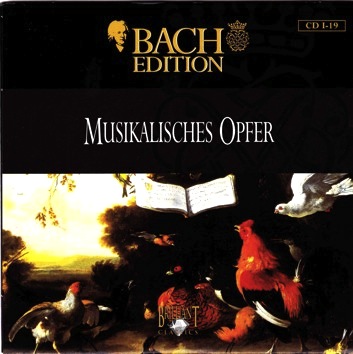 Once again, I have to claim ignorance.
Once again, I have to claim ignorance.
What’s a Musikalisches Opfer?
If that’s another way of saying Monstrous Instrument or Bane of Bill’s Existence then I completely understand.
For this CD begins with harpsichord. Solo. Played at a pace that makes a funeral procession seem hasty. Need I say more?
There’s an old joke about the ad agency called Batten Barton Durstine and Osborn (BBDO now). Jack Benny, on his radio program broadcast 11/21/48, quipped that the agency’s name “sounds like a trunk falling down stairs.”
I know what he meant. For I have heard the music of the harpsichord.
But all this harpsichord discord aside, let’s get back to my original question: What’s a Musikalisches Opfer?
Now I see. According to its entry on Wikipedia,
The Musical Offering (German title Musikalisches Opfer or Das Musikalische Opfer), BWV 1079, is a collection of canons and fugues and other pieces of music by Johann Sebastian Bach, all based on a single musical theme given to him by Frederick II of Prussia (Frederick the Great), to whom they are dedicated. The Ricercar a 6, a six-voice fugue which is the highpoint of the entire work, was put forward by the musicologist Charles Rosen as the most significant piano composition in history (partly because it is one of the first). This Ricercar is also occasionally called the Prussian Fugue, a name used by Bach himself.
The Musical Offering. Cool. I learned something new again today.
I also learned that 40 snippets of music, most of which features the harpsichord, the totality of which tops 60 minutes, tries my patience. And finds it guilty.
Again, my lack of interest in today’s selection isn’t due to poor performances or lousy recordings. On the contrary, today’s recording (made in 1999) is exceptionally crisp and compelling. For example, the violin in BWV 1079, Thematic Regil, Elaborationes Canonicae, movements four and five (“Canon a 2 per augmentationum” and “Canon a 2 per tonos”) feature a very good violin tone, one of the best I’ve ever heard. But the tracks also feature the harpsichord in large measure, which nearly cancels it out.
But the very next movement (“Fuga canonica in Epidiapente”) adds the necessary third and fourth instruments (flute and cello) to balance out the harpsichord, to augment it in a pleasing way.
So there’s the Harpsichord Rule, subset Three-Instrument Rule: Harpsichord by itself is grating. Harpsichord and another instrument creates discord in my mind. But harpsichord and a third (or fourth) instrument creates a blend that I find pleasing. Is that strange, or what?
It’s virtually impossible to tell all of these compositions apart. Or even appreciate them. This one CD could keep a person occupied for days, perhaps even weeks. All I can do is react to certain instruments or tones when I hear them. For example, the flute is such a pleasant instrument. When it appears (as it does, for example, in the Thematis Regil, Elaborationes Canonicae, movement eight, “Canon a 2”), I immediately take notice.
Another instrument I notice is the organ. That has such a rich tone — especially when used to counterpoint the more harsh harpsichord tone — that I find myself feeling soothed. Example: Canon a BWV 1074, part II. The piece begins with a couple of notes from the harpsichord, but then adds the organ. It’s a great combination of keyboard instruments and, despite the fact that it violates the Three-Instrument Rule noted earlier, I like it.
There are a few “deest” compositions here. “Deest,” being a term that means “not present,” or not part of the catalog. For example, if a composition is newly discovered or recently attributed to Bach. Then it’s given a “deest” status to indicate that it’s an aberration of sorts.
I could write about this CD all day. But I don’t have the time. The compositions run the gamut and were composed all during Bach’s lifetime, from when he was 28 until he was 64. So they’re all different, each interesting (or infuriating) in its own way.
The compositions on today’s CD are:
BWV 1079 — 1747 (Bach was 62)
BWV 1072 — unknown
BWV 1073 — 1713 (Bach was 28)
BWV 1074 — 1727 (Bach was 42)
BWV 1075 — 1734 (Bach was 49)
BWV 1076 — Before 1747, so unknown
BWV 1077 — 1747 (Bach was 62)
BWV 1078 — 1749 (Bach was 64)

 You can call me Johann. But don't expect me to answer to that.
You can call me Johann. But don't expect me to answer to that.
No Comments so far ↓
There are no comments yet...Kick things off by filling out the form below.